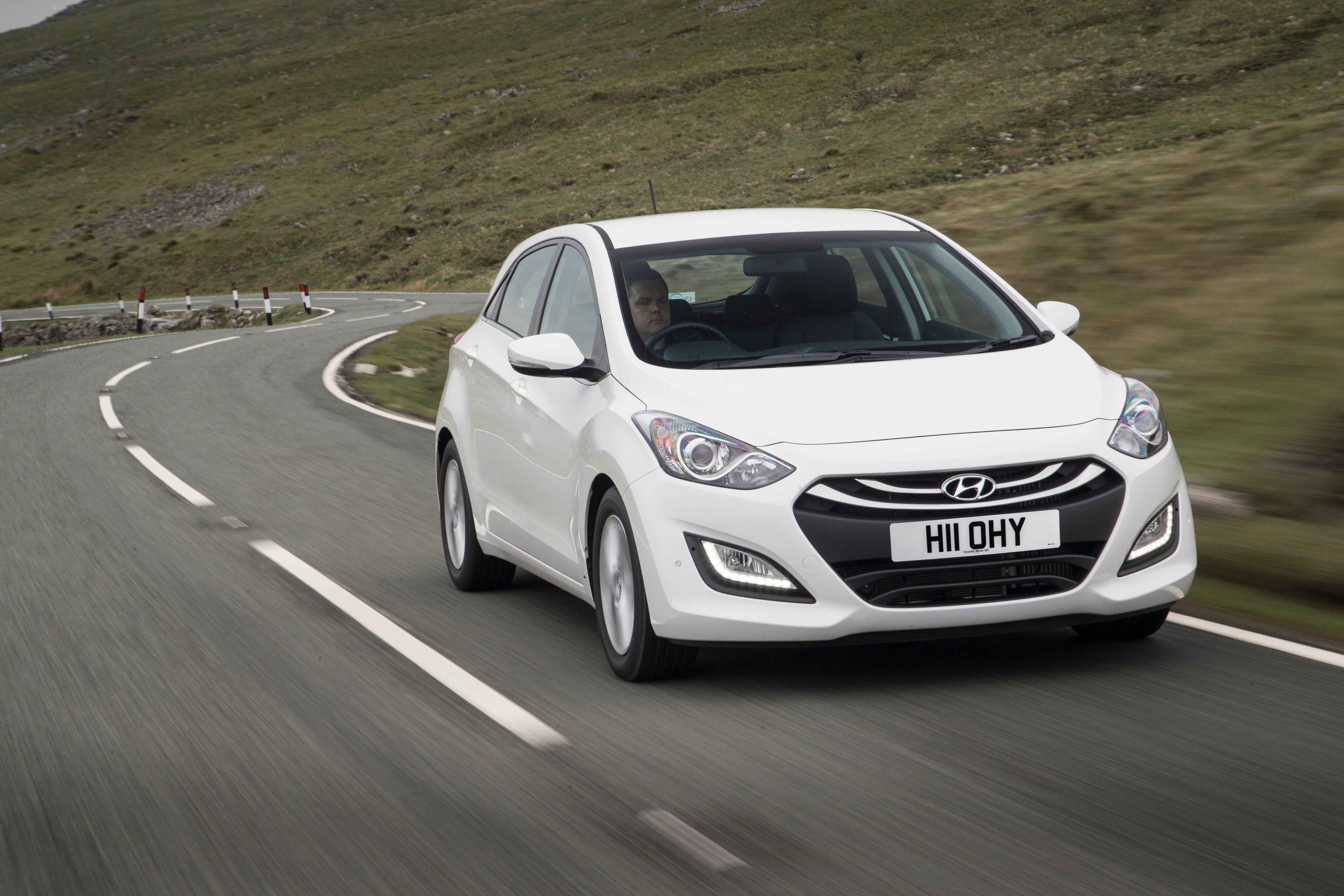Hyundai i30 (2012-2017) Review
Written by Andrew Brady
Quick overview
Pros
- Outstanding value for money
- Extremely reliable and dependable
- Well-equipped
Cons
- Not as alluring as a Volkswagen Golf
- Interior isn’t very exciting
- Disappointing 1.6 T-GDI turbo model
Overall verdict
"Thanks to its reliability, value for money and a fine range of all-round abilities, the Hyundai i30 is hard to fault for the money. It also backs up tempting purchase prices with excellent economy and low tax liability. Add in good levels of standard equipment and you can see how the Hyundai adds up."

The Hyundai i30 was a breakthrough car. It was the South Korean company’s first genuinely convincing offer in the vital family hatchback market, going up against best-sellers such as the Volkswagen Golf. The first generation, launched in 2007, was good, and was further enhanced when this all-new second-generation model arrived in 2012.
It was clear Hyundai had done its homework and thoroughly researched the competition - the i30 was a genuinely convincing alternative to the familiar best-sellers in every way. The three-door or five-door hatchback body looked neat, was the right size outside and in, the cabin was practical, and a comprehensive range of engines all performed well, with low CO2 emission and good mpg.
Crucially, the i30 also sold for prices significantly below the opposition. Value was front and centre here: this wasn’t a cheap-and-cheerful car, but it did offer plenty for the money. All of these attributes carry through to the secondhand market, with the Hyundai carrying one extra card up its sleeve: a remarkable five-year, unlimited-mileage warranty.
That the company had the confidence to offer this, safe in the knowledge it wouldn’t bankrupt it in the longer term, shows what a solid and dependable machine the i30 is. It’s a car you know you will be able to drive for five years and endless miles and almost guarantee its faultless operation. This won’t cease when the five years is up, either: even the oldest i30s remain dependable machines to own.
You’re probably not expecting the most exciting car to drive, and you’d be right. A Ford Focus is more dynamic, while a Volkswagen Golf is more grown up. Yet the i30 is still a very capable performer, with a driving experience that’s well above average. Petrol engines were good, but the most popular when new were the CRDi diesels, particularly the 1.6-litre. This is a great all-rounder, with more than enough grunt and eye-opening fuel economy figures.
Handling is responsive, the ride is comfortable and the i30 eats up high mileages with genuine reassurance. Noise levels aren’t too high, and most engines don’t use too much fuel. The thirstiest is the 1.6-litre T-GDi turbo, which is actually the most disappointing i30, as well as the most expensive. Save your money and stick with the mainstream models instead.
On the outside, the i30 has some reasonably bold curves and creases, with a pronounced ‘cab forward’ design. It looks poised and ready to go, in a way more rounded rivals like the Vauxhall Astra do not. Inside, it shows off the precise quality that has built Hyundai’s reputation, with the dashboard being rather unadventurous in style but very logical and easy to use. Things were further improved with a facelift in 2015.
The central touchscreen, where fitted, is mounted nice and high, and it is logical and straightforward to operate. Dials are clear, seats are comfortable and the driving position is fully-adjustable. Those in the back won’t exactly be thrilled, but they won’t be uncomfortable, and the hatchback boot has a good amount of space – almost on a par with a Volkswagen Golf.
It’s in sheer value for money that this generation of Hyundai i30 really scores today. Prices from Hyundai dealers start from just £5000, which is highly tempting for a car this capable. The i30 still looks good, drives well and is guaranteed to have plenty of life left. Read on to find out how to bag yourself a bargain.
If you're looking for the newer version, you need our Hyundai i30 (2017-) review.
Is the Hyundai i30 right for you?
Looking for one of the most reliable family hatchbacks for the money? Look no further. The dependable Hyundai i30 is a safe bet that sells for tempting prices and serves up family-friendly motoring that should not disappoint.
The Hyundai is roomy and practical, all models are well equipped and no engine is a duffer. If you like the look of a Volkswagen Golf but don’t want to commit to spending so much, the i30 is a great alternative that ticks all the boxes of its more well-known German rival.
If, however, you’re a keen driver seeking a sensible alternative to a sports car, you may be better off with something like a Ford Focus. The i30 is capable and competent, but it doesn’t deliver the last edge of engagement like the Ford.
What’s the best Hyundai i30 model/engine to choose?
The best all-round engine is the 1.6-litre CRDi diesel. The Blue Drive-branded motors with stop-start turn in some exceptional fuel economy figures and CO2 emissions are correspondingly low, which is great for road tax. When revved, it can be a bit noisy, but there should be enough torque in reserve to make this unnecessary during everyday driving – simply press the accelerator and the car will begin to surge forward.
Cheaper models use a 1.4-litre petrol engine. This is fine for those based in the city, but petrol car fans may find the extra power of the 1.6 useful if they frequently go beyond suburbia. As for trim levels, Classic has all the basics, but we prefer Active and Style – and with Style Nav, you get built-in sat nav, which is a handy extra.
What other cars are similar to the Hyundai i30?
The Volkswagen Golf is the default family hatchback in this sector, so is a clear alternative – as are the Ford Focus and Vauxhall Astra. Renault offers the Megane and there’s also the Peugeot 308. If you like Japanese reliability instead of, well, Hyundai reliability, perhaps try the Toyota Auris, Honda Civic or Mazda 3.
The closest rival to the Hyundai actually comes from its sister company, Kia. The Kia Cee’d uses the same platform and engines, and broadly mirrors the line-up of models seen in the i30 range. The only thing you won’t get is the five-year, unlimited-mileage warranty: Kia instead offers seven years, but limits mileage to 100,000.
Comfort and design
"The Hyundai i30’s interior maybe isn’t as instantly appealing as that of a Volkswagen Golf, but don’t be deterred. Once you sit inside, you’ll notice the perfectly fine quality and logical layout tof plentiful gadgets – some which may be lacking in the more expensive Golf."
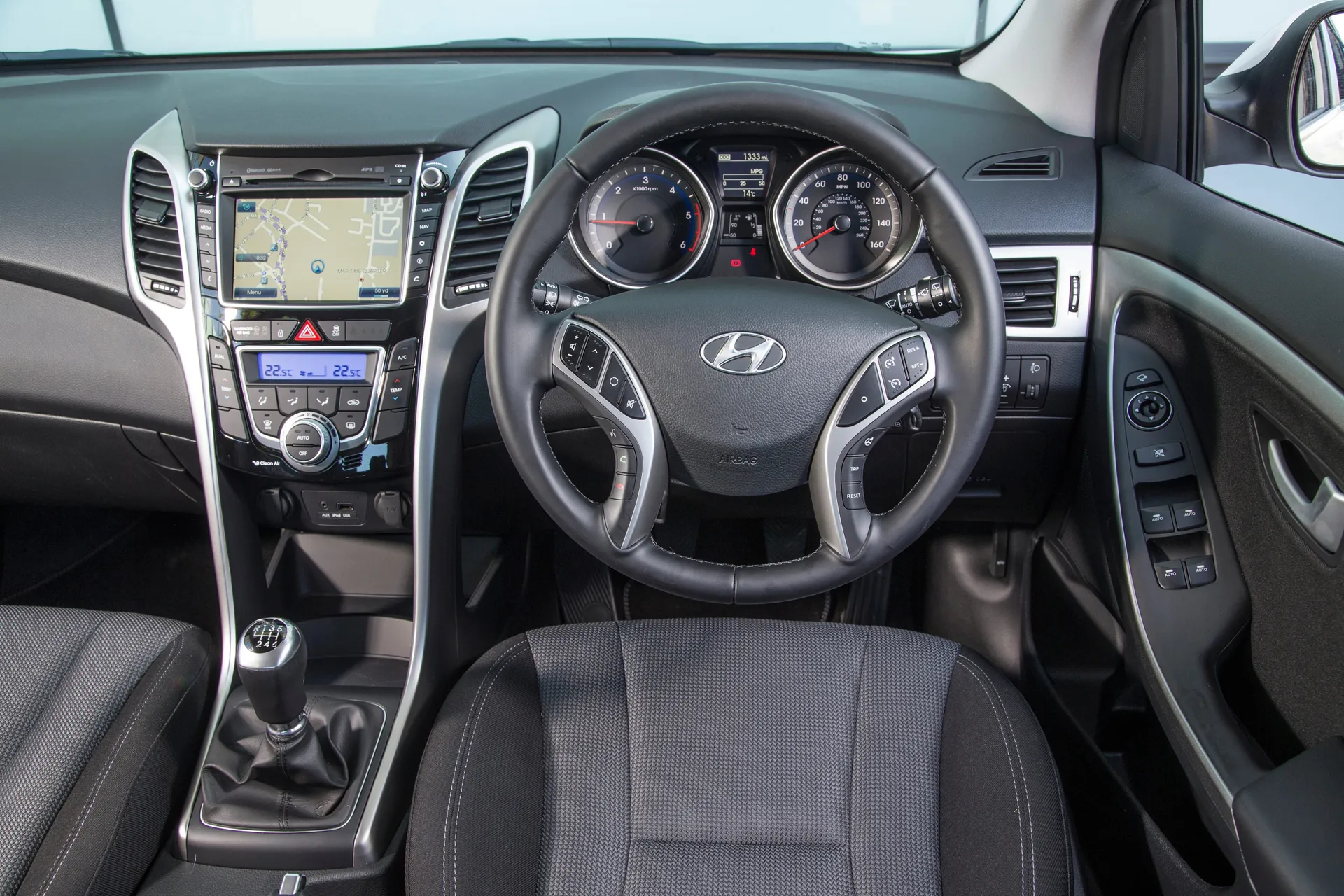
The ample seats support you well, with reasonable side bolstering making them comfortable to sit in. The driving position is hard to fault, and the floor-mounted accelerator pedal is a luxury touch that takes some of the pain out of long-distance journeys. The leather steering wheel perhaps feels a bit cheap, but it offers plenty of adjustment and there’s a good array of buttons on there, including to control Bluetooth telephone calls.
Hyundai’s swooping design makes it feel more dynamic than a Golf, with the door panels flowing into the dashboard, which plunges downwards into the centre console. The instruments are set within deep cowls and the interior is bathed in a cool blue glow at night.
It’s a practical design as well. Mounting the climate controls or heater dials higher on the centre console has freed up space for a large and practical storage space below. With two cupholders further back and large door bins either side, Hyundai i30 occupants shouldn’t be short of space to put their possessions.
Quality and finish
You can sense this is a well-built car even as you open the door. The handles feel sturdy, the paintwork looks good quality and the many lines on the bodywork all flow accurately through the different panels, with no misaligned joins or wide panel gaps.
Inside, it’s the same. Those bold, sweeping shapes curve smoothly across the cabin, with nothing looking ill-fitting or out of place. The plastics have a good feel of integrity, although they are a bit shiny in places – this era of Golf remains the standard-setter here and the Hyundai can’t match it.
We like some of the neat details, such as the centre air vents that are set within their own exposed plastic trim frame, which feeds down the dashboard to surround the gearlever. It’s all very smartly finished and is a nice contrast to some of the harder plastics surrounding it.
Most importantly, everything should still work with an as-new feel. The flakiness you find in some cars after a few years won’t be present in the i30, because it’s finished so well in the first place.
Infotainment
Infotainment is pretty good for this era of car, with the colour touchscreen mounted high up on the dashboard beneath its own hooded binnacle. It’s only available on high-end models with sat nav though - regular i30s get a normal audio system with a non-touchscreen blue-lit display.
The touchscreen system is comprehensive and easier to use than some rival efforts (we’re looking at you, Ford Focus). Setting destinations is straightforward, routes appear quickly and it’s easy to adjust the settings while on the move.
Mounting the screen so high on the dashboard means it’s easy to read at a glance, but it can make your arm ache when you’re typing in destinations. Hyundai included a neat touch to help here: a little shelf below the colour screen that you can rest your thumb on. Connectivity is good, with all models featuring Bluetooth and a USB socket.
Space and practicality
The big car-style front seats are comfortable, and the driving position is spot-on, which is a great start. Most motorists find they can get comfortable in an i30 within seconds – particularly with better-spec versions, which have height-adjustable seats. The seats are trimmed in hard-wearing cloth, while top-spec versions have the luxury of heated leather chairs.
Visibility is good, helped by the side window line that plunges down towards the door mirrors. This opens up the side view and makes the i30 that bit easier to park. However, because the windscreen pillars stretch quite far forward, they can sometimes get in the way when you’re checking traffic to join a roundabout. The rear view is good in the five-door model (the rear pillars are a bit restrictive in the three-door) and many versions have rear parking sensors. Infotainment-equipped models come with a reversing camera.
Rear seat space is OK. Headroom isn’t bad and there’s good room for feet under the front seats. Some might find it a bit cramped if the driver is tall, though – they’ll slide their seat backwards and not leave enough knee room for the passenger behind. The three-door car also feels notably more claustrophobic than the five-door.
With the seats up, the 378-litre boot is class-competitive. Indeed, it’s almost exactly the same size as the Volkswagen Golf. Folding the seats down extends it to 1,316 litres and, in that typically thoughtful Hyundai way, it’s a simple process and they fold down almost flat. The well-shaped boot is easy to load as well.
The rear seats have Isofix mountings for child car seats. They’re easy to snap in place in the five-door, but that bit more awkward in the three-door.
Handling and ride quality
"The Hyundai i30 serves up a thoroughly competent blend of ride and handling with little to complain about. It’s not particularly memorable or headline-grabbing, but there’s nothing that will drive you round the bend either – just a very well-rounded experience that will offend no-one."
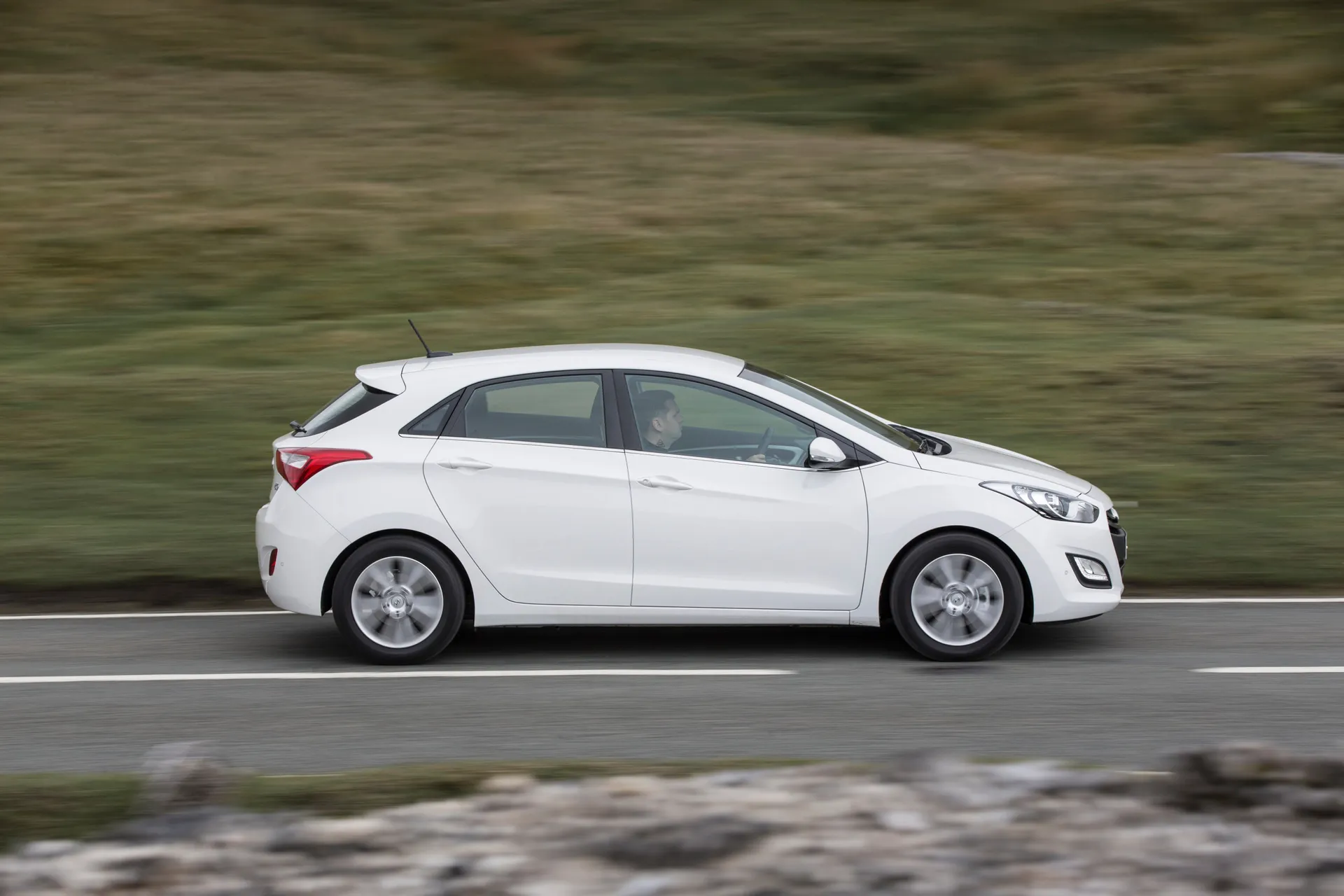
Handling is better than you might expect, actually. Hyundai fitted an expensive multi-link type of rear suspension to the i30, which is more sophisticated than you get in something like a Vauxhall Astra. This helps keep it composed on challenging roads, gives a bit more stability and confidence in bends, and also helps the steering feel sharper and more accurate.
Most models have a so-called ‘Flex Steer’ button on the steering wheel, which has three settings: Comfort, Normal and Sport. This alters the weight of the steering itself – lighter for Comfort, heavier and more responsive for Sport. It’s a novel gadget, but we suspect most people will try it out once, then simply leave it in Normal.
Ride quality is excellent, particularly in models with 15-inch and 16-inch wheels. The i30 rides the bumps well, cushioning road harshness and feeling particularly settled and composed at higher speeds. You can thank the high-tech rear suspension for that - it makes the i30 feel like a car from the class above.
Versions with larger alloys do pick out a bit more disturbance from the road surface, though. On particularly broken tarmac, they can become knobbly and a bit crashy. That’s why we’d rather stick with smaller wheels. They don’t look as exciting, but are more comfortable to live with.
Engines and gearboxes
There’s a decent range of petrol and diesel engines. The entry-level 1.4-litre is better than you might think, if you mainly stick to urban use. It pulls away OK from the line and is reasonably responsive despite its diminutive size. We’d rather have the 1.6-litre petrol if we were covering more daily miles though, as there’s more in reserve. It makes journeys that bit more relaxing.
You can get the 1.6 with an automatic gearbox, too. It’s a bit slow, to be honest, so we’d stick with the light, easy-shift manual. Saying that, the automatic gearbox switched from a dated six-speeder to a much-improved seven-speed DCT from the 2015 facelift. If you need an automatic, make sure it’s a 2015-on car. It will save you a fortune in running costs and prove much nicer to drive.
Most i30s were sold with a diesel engine. The 1.4-litre CRDi is, frankly, a bit underpowered for longer-distance use and it’s not ideal in town either. It’s rather inflexible and dependent on being in the right gear at the right time. Our recommendation is to find a 1.6 CRDi, badged ‘Blue Drive’ to reflect the standard fitment of engine stop-start.
The 1.6 diesel comes in 110PS and 128PS guises, and both are available with an automatic gearbox. Our advice is again to avoid this, as it has a big effect on performance and, in particular, fuel economy.
Both versions of the engine are strong, with good pulling power through the gears. It’s clear the 128PS motor feels the stronger engine, and will be more effortless on long trips, but don’t dismiss the 110PS version as it’s a big step up over the 1.4 CRDi. The diesels are a bit noisy when cold and when revved, but they cruise very quietly and on the motorway, they’re barely audible.
Hyundai later offered a 1.6 turbo petrol engine, but this is a bit disappointing. Despite its headline 186PS output, it never seemed as fast as was claimed. A 0-62mph time of 8.0 seconds was not exactly noteworthy either. You’re much better off with the 1.6 diesel.
Refinement and noise levels
The big car similarities continue with the i30’s impressive refinement. The doors close with a nice thunk, isolating you from the world outside. As you start up and move away, noise doesn’t start to intrude again, either. Road roar isn’t excessive, the engines are only really vocal under acceleration and wind noise is hushed thanks to the car’s aerodynamic design.
As the engines get louder when revved hard, we’d advise you err towards power rather than economy. Given that you won’t have to work them so much, they’ll be quieter in everyday use – and this will have the happy side-effect of keeping fuel economy in check.
Although they’re a bit clattery at times, the 1.6-litre diesel engines are generally quieter overall than the smaller diesels and the petrols, just because they’re more relaxing to drive. You can leave them in gear and let the grunt of the engines do the work, rather than changing down a gear or two.
Safety equipment
All Hyundai i30s came with the important safety features many car buyers take for granted. All-round airbags were included, as was Vehicle Stability Management (electronic stability control) and LED daytime running lights to keep you visible on the road. There was also a function that activated the hazard warning lights when you braked heavily, to warn the car behind.
Euro NCAP awarded this generation of i30 an extremely good safety rating after crash tests – five stars, of course, with 90 percent ratings for both adult occupant and child occupant protection. Standard safety assist gadgetry earned it 86 percent and it’s only in pedestrian protection that it drops below average with a 67 percent rating. It’s also rated as a very safe and stable tow car, being named Best Value Hatchback in the 2012 Towcar Awards.
The brakes are strong, with an electronic parking brake standard for added convenience. In 2015, Hyundai upgraded the size of the front brakes, so they were more effective and powerful: this actually stopped the firm offering smaller 15-inch wheels in certain markets, because they no longer fitted over the front brakes.
The Hyundai i30 has a space-saver spare wheel beneath the boot floor, rather than a full-size one – but some will be reassured by the fact it doesn’t use a tyre repair kit instead.
MPG and fuel costs
"Most Hyundai i30s return good fuel economy figures, but the stars of the show are the CRDi diesels. You’d expect the 1.4-litre CRDi to be good and it doesn’t disappoint, with a combined NEDC average of 68.9mpg."
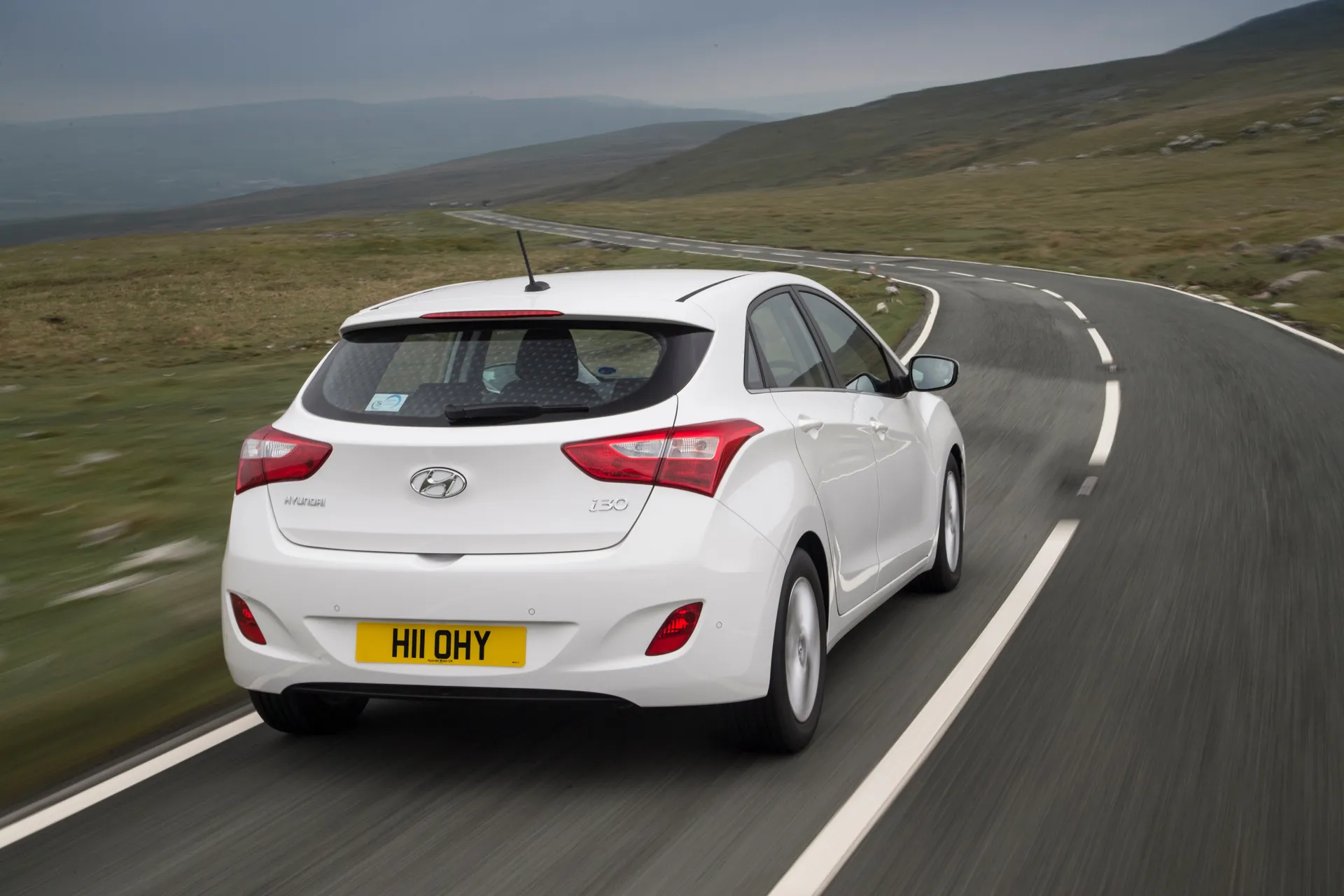
However, the 1.6-litre CRDi Blue Drive 110PS goes one better with an exceptional combined average of 74.3mpg. Hyundai later cranked this up a bit further, with some versions returning 76.3mpg, while even the 128PS version could manage 68.9mpg.
A word on the diesels, though – whereas a 128PS i30 could indeed eke out 69mpg, the automatic version of the same engine plunges this right down to 51.4mpg.
The 1.4-litre petrol engine, while a bit meek, was pretty economical, averaging up to 47.1mpg. The 1.6-litre averaged 44.8mpg and the gap to the automatic version was much less extreme, with that car returning 41.5mpg. It’s worth noting that later automatics, from 2015 onward, were more efficient, as they used the seven-speed DCT gearbox.
The most inefficient Hyundai i30, with the highest fuel costs, is the 38.7mpg 1.6 Turbo. No wonder we prefer the 1.6-litre diesel, which is almost twice as efficient.
Insurance groups and costs
Insurance groups for the Hyundai i30 start from a very low group six and even the sporty Turbo, with its dual exit exhausts and racier engine, comes in no higher than group 21. The 1.4-litre petrol starts from an affordable group seven, and the 1.6-litre petrol seems pretty good to us at group nine.
An entry-level 1.4-litre CRDi diesel is the group six car, but we’d pay a bit more and go for a mid-spec 1.6-litre CRDi Blue Drive, which is rated in group 11. The more powerful 128PS version is a bit higher at group 13, reflecting its enhanced performance.
VED car tax
The excellent economy of the diesel engines goes hand-in-hand with favourable tax rates. Most 1.6-litre diesels still actually enjoy free road tax, thanks to their sub-100g/km CO2 emissions. Even the more powerful 128PS version just sneaks into the A-rated VED tax band, courtesy of exactly 100g/km CO2. The leap up to band F for the automatic versions is a bit painful, and even the 1.4-litre CRDi engine only manages to get into band B.
Petrol engines with a manual gearbox are pretty cost-effective. It will cost £165 to tax the 1.6-litre. The automatic, however, jumps up to £205 a year, because of its higher CO2 emissions. You’ll pay £240 a year to tax the 1.6-litre Turbo.
How much should you be paying for a used Hyundai i30?
"Early 2012 Hyundai i30s can be found for barely more than £5000, which makes them tremendous value for money. Choice at this level includes higher-mileage 1.6-litre CRDi diesels in appealing Style trim, plus lower-mileage 1.4 petrol versions. Interestingly, the 1.6petrol is rare at this price."
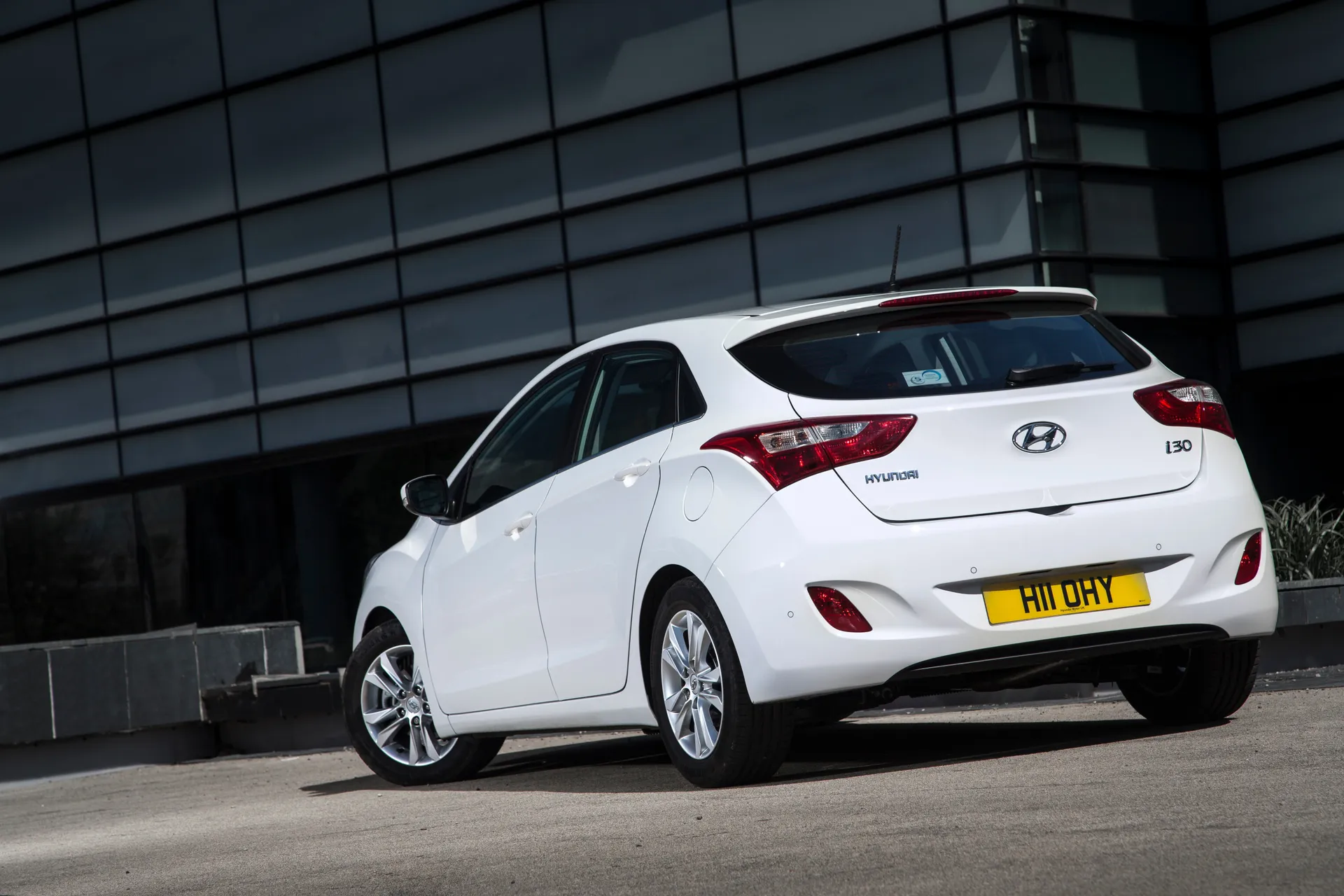
You’ll be able to choose from a range of five-year-old models from upwards of £7000, with a broad spread of trims, colours and engines. Facelifted models come in from around £8000, while those with a budget of £10,000 have a huge amount of choice within the Hyundai i30 range (all cars with plenty of life and a good chunk of the manufacturer warranty left in them).
Trim levels and standard equipment
Another attraction of the Hyundai i30 is a good level of standard equipment. All come with air conditioning, LED daytime running lights, electronic parking brake, Bluetooth, front fog lights and both iPhone and USB connectivity. To the base Classic spec, Active adds 15-inch alloys, rear parking sensors and cruise control.
Style models have larger 16-inch alloys, plus the luxuries of dual-zone climate control, front parking sensors, automatic headlights and wipers, cornering lights and door mirrors that fold away when you lock the car. Style Nav does as its name suggests and adds built-in touchscreen sat nav (the only version to get a colour infotainment screen at launch), complete with a rear parking camera.
A range-topping Premium version was added later, with 17-inch wheels, chrome exterior trim, heated leather seats, keyless entry and an enhanced instrument cluster. A good-value i30 Edition variant came in 2013, with 16-inch alloys, dual-zone climate control, rear parking sensors, all-round electric windows and Bluetooth.
Trim names were updated in 2015, with Classic becoming S and Active becoming SE. The SE Nav and Premium rounded out the range, with a new semi-sporty Turbo variant adding a warm hatch vibe as an alternative to Premium.
Get our latest advice, news and offers
Keep me updated by email with the latest advice, news and offers from heycar.
By submitting you agree to our privacy policy
